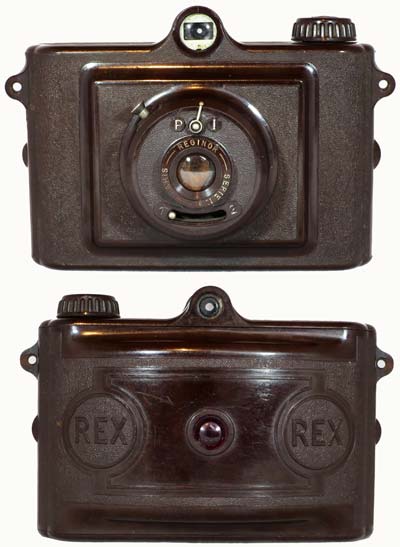MIOM Rex
Specification

| Manufacturer | : | M.I.O.M. |
|---|---|---|
| Produced | : | 1936 |
| Classification | : | Medium Format |
| Body Type | : | Solid Body |
| Construction | : | Brown Bakelite |
| Film Type | : | 127 |
| Film Width | : | 46mm |
| Image Size | : | 4 x 6 cm |
| No. of Images | : | 8 |
| Lens Type | : | Paris Reginor Series IIa |
| Focal Length | : | 60mm |
| Focus Type | : | fixed |
| Focal Range | : | 8ft - Inf. |
| Aperture Type | : | Variable stops |
| Apertures | : | f/16, f/22 |
| Shutter Type | : | Rotary |
| Shutter Speeds | : | P(Bulb), I(1/50s) |
| Size (w x h x d) | : | 135 x 90 x 72 mm |
| Weight | : | 285g |
Art Deco Credentials
![]()
![]()
Acceptable: Modest and restricted
- Produced during the main Art Deco period.
- Brown Bakelite body
- Curvilinear and stepped body shape.
- Speckled grain panels to body.
- Ornate design on rear.
- Symmetrical shape.
Description
Around 1936, MIOM diversified into manufacturing cameras. The first were small simple 4 X 6cm 127 cameras like this Rex but it went on the produce the famous Photax Blindé.
The Rex is made of black or chocolate brown Bakelite. It has a curvilinear design with speckled grain panels. The Paris Reginor Series IIa meniscus lens can be stopped down for f/16 or f/22. The choice of stop is made by moving a small sliding nipple underneath the lens. It has a simple T/I shutter with a rather snazzy lever above the lens marked 'P' (bulb) and 'I'. The film plane is curved. The viewfinder is a reverse Galelean type. It has a red window in the centre of the back. It has a tripod mount on the bottom.
How to Use
This camera takes 127 film which is still available from select outlets - search for 'Rera Pan 100-127' which is a black & white film. For those photographers in the UK, try Nick & Trick photographic services. If you want to use a particular type of film which is not available commercially, then you can cut your own 127 film from any 120 film. See my page on 'How to cut 127 film from 120 film'.
The Rex supports instant(I) mode with a speed of about 1/50 sec. It has two aperture settings of f/16 and f/22. With a shutter speed of only 1/50 sec, make sure you brace the camera against your face or something solid and press the shutter smoothly to avoid camera shake. Don't forget to cover the red window with black tape as modern films are sensitive the red light. Only remove the tape when advancing the film in subdued light.
If you don't want to bother with an exposure meter, follow the guide shown. It is based on the 'Sunny 16' rule. Film is so forgiving and will produce acceptable results even when over-exposed by 2 or 3 stops or under-exposed by 1 stop.
The table shown assumes the shutter speed is about 1/50s.
The table also assumes that the sun is at least 30 degrees above the horizon - that's 10am - 5pm on a summers day in the UK.
Remember that the exposure guide in the manual may not be helpful as it is based on the use of old film with a low ISO value.
Using ISO 100/125 film - shutter speed 1/50s
| Weather Conditions | Shadow Detail | Aperture | Exposure |
|---|---|---|---|
 Sunny SunnySnow/Sand | Dark with sharp edges | f/22 | +1 Stop Overexposed Acceptable |
 Sunny Sunny | Distinct | f/22 | Good |
 Slight Overcast Slight Overcast | Soft around edges | f/16 | Good |
 Overcast Overcast | Barely visible | f/16 | -1 Stop Underexposed Acceptable |
 Heavy Overcast Heavy Overcast | None | f/16 | -2 Stops Underexposed Not Acceptable |
 Open Shade Open Shade/Sunset | None | f/16 | -3 Stops Underexposed Not Acceptable |